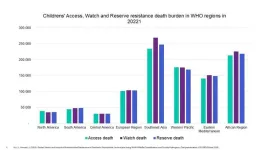Over 3 million children died from AMR-related infections in 2022, major study shows
A landmark study presented today at ESCMID Global 2025 has revealed that over 3 million children worldwide lost their lives in 2022 due to antimicrobial resistance (AMR)-related infections
2025-04-12
(Press-News.org) A landmark study presented today at ESCMID Global 2025 has revealed that over 3 million children worldwide lost their lives in 2022 due to antimicrobial resistance (AMR)-related infections.1
The study underscores the urgent need for both regional and global strategies to control paediatric AMR, particularly in high-burden areas such as South-East Asia and Africa. AMR poses a critical threat to children, who are highly vulnerable to infections.2 Access to new antibiotic formulations is often much more limited for children because of product development delays.
The study data found that in 2022 alone, more than 752,000 children in Southeast Asia and 659,000 children in Africa died of AMR-associated complications. Many of these deaths were linked to the use of Watch antibiotics (drugs with a high risk of resistance) and Reserve antibiotics (last-resort treatments for severe, multidrug-resistant infections).1,3
Watch and Reserve antibiotics are not intended for first-line treatment and their use should be limited only for those who need them to preserve their effectiveness and reduce the development of resistance. In contrast, Access antibiotics are those that are more widely available and used to treat common infections due to their lower potential for increasing resistance.
Between 2019 and 2021, the use of Watch antibiotics increased by 160% in Southeast Asia and 126% in Africa. During the same period, the use of Reserve antibiotics rose by 45% in Southeast Asia and 125% in Africa.
Globally, of the more than 3 million children’s deaths, 2 million were associated with the use of Watch and Reserve antibiotics.
“While the rise in use of Watch and Reserve antibiotics may be necessary in response to the concurrent rise in drug-resistant infections, the sharp rise in use of these drugs presents several serious long-term risks”, commented Professor Joseph Harwell, study co-author. “Their increased use, especially without careful oversight, elevates the risk of resistance and limits future treatment options. If bacteria develop resistance to these antibiotics, there will be few, if any, alternatives for treating multidrug-resistance infections.”
Several factors contribute to the severity of AMR in low- and middle-income countries, including overcrowded hospitals, poor sanitation, and weak infection prevention measures that facilitate the spread of resistant pathogens within healthcare settings and communities. Due to a lack of diagnostic tools and concerns over misdiagnosis, overuse and misuse of antibiotics are also widespread in these regions. Additionally, many low- and middle-income countries lack effective national surveillance and antimicrobial stewardship programmes, making it difficult to track resistance trends and establish effective treatment protocols.
“Rising resistance to Watch and Reserve antibiotics will ultimately lead to higher treatment failure,” said Professor Harwell. “Mortality rates, which are already alarmingly high, will continue to rise significantly, particularly in low- and middle-income countries where access to alternative treatments and advanced medical interventions may be limited.”
Professor Harwell furthered, “Addressing this issue requires urgent and coordinated action at both the regional and global levels. Global and national surveillance on AMR must adopt a ‘One Health’ approach, with cost-effective systems that can inform treatment guidelines and measure the impact of control interventions.”
“On a regional level, we call on policymakers to mandate hospital-based antimicrobial stewardship programmes in all paediatric healthcare facilities. Improved age classifications in surveillance data will also enhance our understanding of important differences in resistance rates across the age categories, as well as paediatric-specific resistance mechanisms. Additionally, we urge the implementation of national guidelines to ensure routine surveillance informs antibiotic use,” concluded Professor Harwell.
ENDS
Notes to Editors:
A reference to ESCMID Global must be included in all coverage and/or articles associated with this study.
For more information or to arrange an expert interview, please contact the ESCMID Press Office at: communication@escmid.org or the Clinical Health Access Initiative at: sibraheem@clintonhealthaccess.org
About the study data
The study incorporated data from the Pfizer ATLAS programme provided through the Vivli platform, along with WHO’s GLASS on antibiotic use, the World Bank data on demographics, and IHME mortality data.
About Access, Watch and Reserve antibiotics4
Access antibiotics are antibiotics with a narrow spectrum of activity, generally with less side-effects, a lower potential for the selection of antimicrobial resistance and of lower cost. They are recommended for the empiric treatment of most common infections and should be widely available.
Watch antibiotics generally have a higher potential for the selection of antimicrobial resistance and are more commonly used in sicker patients in the hospital facility setting. Their use should be carefully monitored to avoid overuse.
Reserve antibiotics are last-resort antibiotics that should only be used to treat severe infections caused by multidrug-resistant pathogens.
About the study authors:
Professor Joseph Harwell is a Senior Clinical Director at Clinton Health Access Initiative, and Associate Clinical Professor of Medicine and Pediatrics at the Warren Alpert Medical School of Brown University, United States.
Doctor Yanhong Jessika Hu is Honorary Senior Research Fellow at Murdoch Children’s Research Institute, Royal Children’s Hospital and Department of Paediatrics, University of Melbourne, Australia
About the European Society of Clinical Microbiology and Infectious Diseases:
The European Society of Clinical Microbiology and Infectious Diseases (ESCMID) is the leading society for clinical microbiology and infectious diseases in Europe. ESCMID is proud to unite over 12,000 members as well as 45,000 affiliated members through 77 national and international affiliated societies. ESCMID’s mission is to champion medical progress in infection for a healthier tomorrow and plays an important role in emerging infectious diseases and antimicrobial resistance education and research.
Website: www.escmid.org/
References:
Hu, Y., Harwell, J. (2025). Global Trends and Impact of Antimicrobial Resistance in Paediatric Populations: An Analysis Using WHO AWaRe Classification and Priority Pathogens. Oral presentation. ESCMID Global 2025.
UNICEF UK. (n.d.). Antimicrobial Resistance: A Crisis for Children Everywhere. Available at: http://unicef.org.uk/campaign-with-us/futures-at-risk/antimicrobial-resistance-a-crisis-for-children-everywhere/
National Library of Medicine. (2023). The WHO AWaRe (Access, Watch, Reserve) antibiotic book and prevention of antimicrobial resistance. Available at: https://pmc.ncbi.nlm.nih.gov/articles/PMC10042089/
World Health Organization. (2022). The WHO AWaRe (Access, Watch, Reserve) antibiotic book. Available at: https://www.who.int/publications/i/item/9789240062382 END
[Attachments] See images for this press release:

ELSE PRESS RELEASES FROM THIS DATE:
2025-04-12
New research to be presented at this year’s European Congress on Obesity (ECO 2025, Malaga, Spain, 11-14 May) shows that the proportion of adolescents living with overweight or obesity in England has increased by 50% from 2008-2010 (22%) to 2021-2023 (33%). The research, presented in two studies, is by Dr Dinesh Giri, Consultant Paediatric Endocrinologist, Bristol Royal Hospital for Children and Honorary Senior Lecturer, University of Bristol, Bristol, UK, and Dr Senthil Senniappan, Consultant Paediatric Endocrinologist, Alder Hey Children’s Hospital, Liverpool, UK, and colleagues.
Previous ...
2025-04-12
The First International Conference on Cyborg and Bionic Systems (ICCBS 2025) will be held in Singapore, Republic of Singapore, from July 24 to July 26, 2025. This conference aims at providing a free, open, and diverse platform for experts, scholars, students and industry professionals from the fields of robotics, biomedical engineering, neural engineering, and related domains. The sponsor of the conference is Beijing Institute of Technology, and the organizer of the conference is the Journal Cyborg and Bionic Systems.
We look forward to welcoming experts, scholars and industry leaders from around ...
2025-04-11
Breakthrough study identifies promising biomarker for early sepsis detection in neonates, children, and pregnant women
A pioneering study presented today at ESCMID Global 2025 has uncovered the potential of interleukin-6 (IL-6) as a powerful diagnostic biomarker for the early detection of sepsis in high-risk patient groups, including neonates, children and pregnant women. This study is the first to evaluate IL-6’s diagnostic performance in a real-world cohort across all three populations.1
Sepsis, a life-threatening condition resulting from the immune system’s overreaction to infection, remains a leading global cause of mortality, accounting ...
2025-04-11
New research to be presented at this year’s European Congress on Obesity (ECO 2025, Malaga, Spain, 11-14 May) shows that around two thirds of participants of the SURMOUNT-1 trial had only regained 5% or less of their so-called nadir (or lowest weight) three years after beginning treatment with tirzepatide. The study is by Professor Louis Aronne, Comprehensive Weight Control Center, Division of Endocrinology, Diabetes, and Metabolism, Weill Cornell Medicine, New York, NY, USA, and co-authors from Eli Lilly and Company, Indianapolis, IN, USA, which funded the study.
Obesity management is a long-term journey during which fluctuations ...
2025-04-11
Once-weekly treatment with tirzepatide can produce clinically meaningful and sustained weight loss for at least 3 years in adults with overweight or obesity who do not have diabetes, according to new research being presented at this year’s European Congress on Obesity (ECO) in Malaga, Spain (11-14 May). The findings also indicate that females and those without obesity-related complications may be more responsive to tirzepatide treatment.
The study, led by Dr Luca Busetto from the University of Padova in Italy and colleagues from Eli Lilly and Company that manufacture tirzepatide, is a continuation of the SURMOUNT-1 phase 3 trial of tirzepatide, a medication approved in ...
2025-04-11
Common respiratory condition nearly triples the risk of death in adults, new study finds
A major study presented today at ESCMID Global 2025 has revealed that adults with respiratory syncytial virus-associated acute respiratory infection (RSV-ARI) face a 2.7-fold higher risk of death within one year compared to the general population.1
The findings underscore the significant, yet often under-recognised, long-term health and economic burden of RSV-ARI in adults, particularly among those with underlying conditions such as chronic obstructive pulmonary disease (COPD) and asthma.
RSV-ARI refers ...
2025-04-11
New research recently published in Archives of Sexual Behavior suggests children’s gender biases can be reflected in their facial emotional expressions.
Psychology professor Doug VanderLaan and his colleagues at the University of Toronto Mississauga, studied 296 children (148 boys and 148 girls) in Canada between the ages of four and nine years old while Wang Ivy Wong, Karen Kwan and their colleagues at the Chinese University of Hong Kong, and The Hong Kong Polytechnic University studied 309 children (155 boys and 154 girls) in Hong Kong. All children watched four short stories that included five illustrations with pre-recorded audio narratives. ...
2025-04-11
Woods Hole, Mass. (April 11, 2025) - Being a geophysicist can sometimes feel like being a detective —uncovering clues, and then building a case based on the evidence.
In a new article published in Science Advances, a collaborative team led by the Woods Hole Oceanographic Institution (WHOI), presents a never-before-seen image of an oceanic transform fault from electromagnetic (EM) data collected at the Gofar fault in the eastern Pacific Ocean. The National Science Foundation funded work reveals ...
2025-04-11
Reston, VA (April 11, 2025)—New research has been published ahead-of-print by The Journal of Nuclear Medicine (JNM). JNM is published by the Society of Nuclear Medicine and Molecular Imaging, an international scientific and medical organization dedicated to advancing nuclear medicine, molecular imaging, and theranostics—precision medicine that allows diagnosis and treatment to be tailored to individual patients in order to achieve the best possible outcomes.
Summaries of the newly published research articles are provided below.
Tracing Prostate Cancer Beyond the Usual Path
Researchers uncovered ...
2025-04-11
Using electrodes in a fluid form, researchers at Linköping University have developed a battery that can take any shape. This soft and conformable battery can be integrated into future technology in a completely new way. Their study has been published in the journal Science Advances.
“The texture is a bit like toothpaste. The material can, for instance, be used in a 3D printer to shape the battery as you please. This opens up for a new type of technology,” says Aiman Rahmanudin, assistant professor at Linköping University.
It is estimated that more than a trillion gadgets will be connected to the Internet in ten years’ time. In addition to traditional ...
LAST 30 PRESS RELEASES:
[Press-News.org] Over 3 million children died from AMR-related infections in 2022, major study shows
A landmark study presented today at ESCMID Global 2025 has revealed that over 3 million children worldwide lost their lives in 2022 due to antimicrobial resistance (AMR)-related infections


